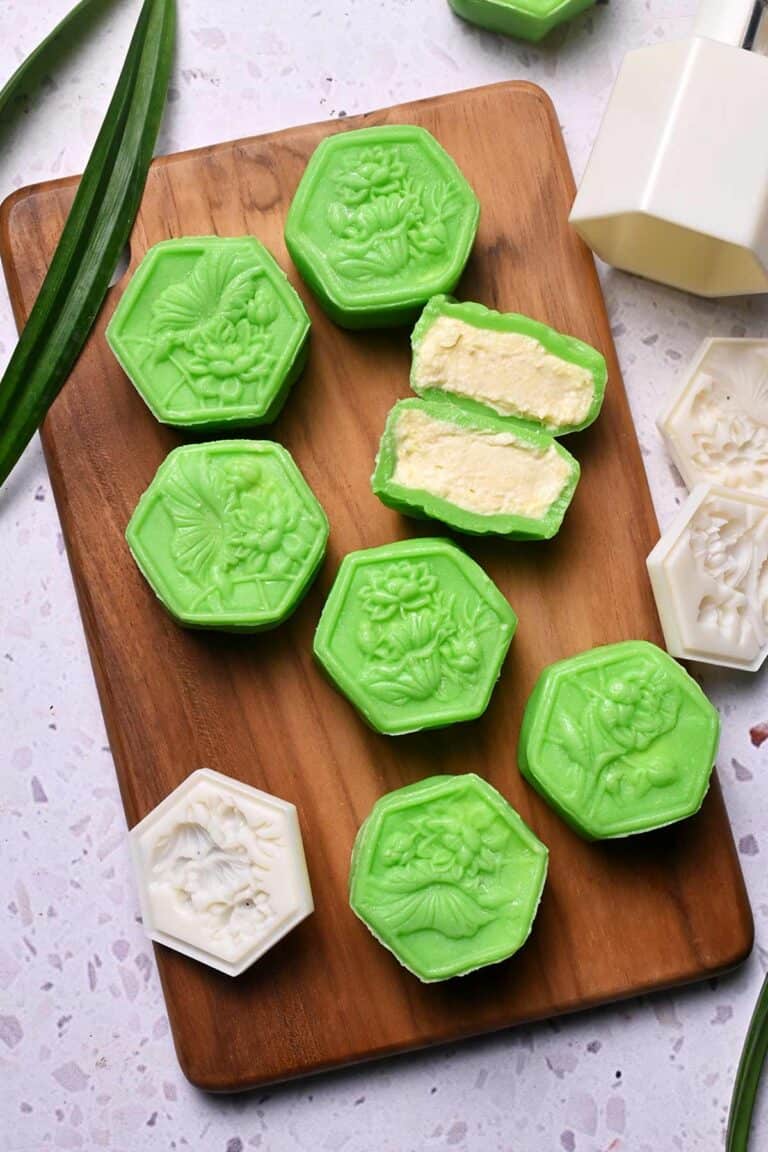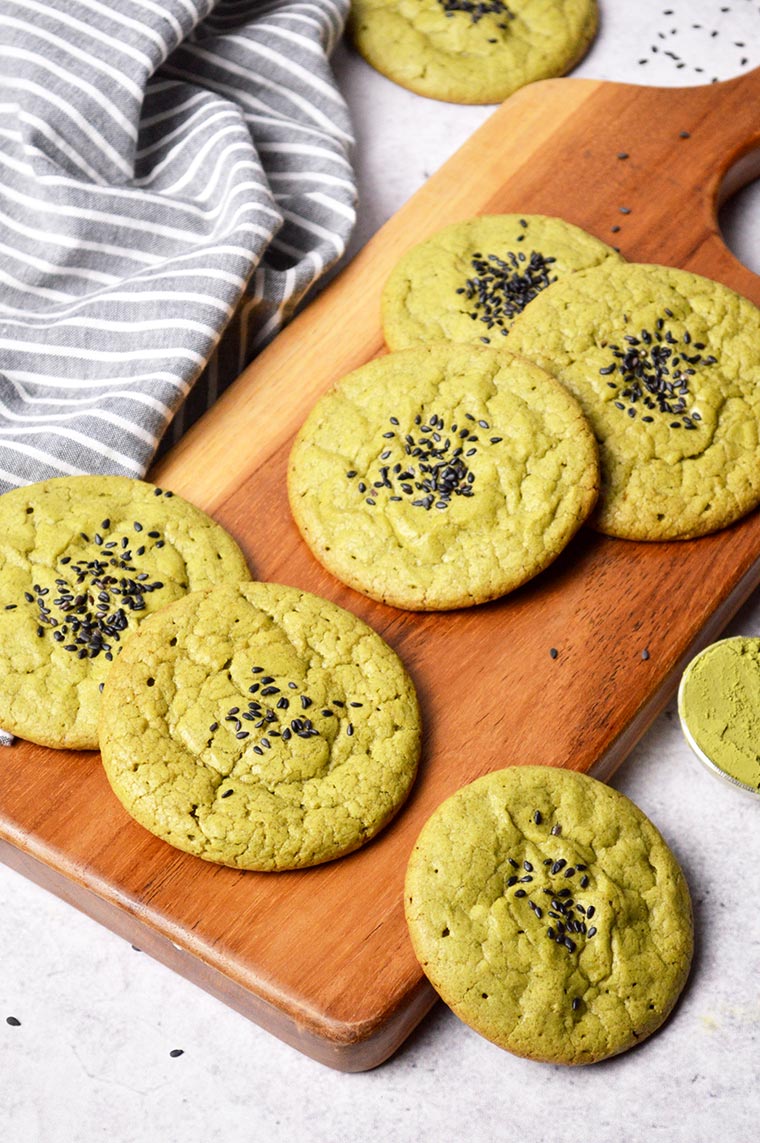Mitarashi Dango
This post may contain affiliate links. Please read my disclosure policy for details.
These irresistible Mitarashi Dango are a combination of soft and chewy rice dumplings skewers smothered in sweet and salty soy sauce glaze.

As everyone knows, food is probably one of the biggest attractions in Japan. You cannot miss trying a variety of local snacks sold on the street. I stumbled upon this awesome dango shop right at the entrance of Arashimaya Bamboo Forest in Kyoto during my last vacation to Japan. Dango are sweet rice dumplings that are skewered onto a bamboo stick. The dango sold at this stand was traditional dango with sweet soy sauce glaze (Mitarashi Dango) and sweet red bean paste topping. I chose the one with sweet soy sauce glaze because of its visual and it tasted so good.

The taste of sweet soy sauce glaze hit me first. You know the situation when you crave something salty when you eat sweets, and vice versa. The marriage of sweet sugar and salty flavor from soy sauce is the perfect taste combination. It was so satisfying that I could not get enough of it
Then, I took a bite of the rice dumplings. Each bite tasted mildly sweet with a chewy and gooey texture. The charred part was what drew me in more. It gave the rice dumplings a great flavor and crisp exterior. Combined with the glaze, the texture and flavors make dango a really special treat, especially to me.
I also made the red bean version after making this. You can find the recipes at Dango with Red Bean Paste.
How to Make Mitarashi Dango
You do not need to especially visit Japan to enjoy this delicacy because you can make them in your kitchen. I thought that making dango was pretty difficult at first. But, trust me they are as easy as making Chinese glutinous rice balls or tang yuan. Here is step by step how to make the recipe with some useful tips that I hope pretty helpful for you.
1. Choose your flour
Dango is made from rice flour, but there are actually a few kinds of rice flour in Japan, called dangoko, joshinko, and shiratamako. They are all made from rice. The differences are in the process of making each flour and also the type of rice.
For the recipe, I used dangoko because that is what I had at the moment. I bought this dangoko at a local supermarket in Japan during my last vacation there. I had not done my research at that time and decided to buy it solely because of the dango visual on the packaging. They are firmer than the ones I tried in Kyoto. In fact, many people recommend making dango from the combination of joshinko and shiratamako for softer dango.

Shiratamako is from sweet glutinous Japanese short-grain rice. When you make dango with only shiratamako, the texture tends to be too soft. Therefore, joshinko which comes from regular short-grain Japanese rice is usually added with shiratamako to make the right dango texture. Of course, you can make dango with shiratamako only, depending on your availability and personal preference. For the best consistency, you can substitute dangoko with a proportion 50-50 ratio for joshinko and shiratamako.
2. Soak the skewers in water
Wooden skewers, like the classic bamboo skewers, can burn easily over a hot grill. Soaking them in water for about 30 minutes will make them last longer on the grill without burning up.
3. Make the dango dough
Making dango is just like making Chinese glutinous rice balls. They are made by mixing dangoko with warm water. This step is a little bit tricky because rice flour behaves like cornflour. A little too much water will make the dough too runny, while too much flour will make the dough cracks. Depending on the humidity, you will need to add more or less water. So, my suggestion is to add warm water a little at a time to the flour and knead until the dough comes together.

After that, take some dough in your palms and measure the weight each about 20 grams. Then, roll them into small balls (each about 1-inch diameter). I got 19 small balls from the recipe.

4. Cook the dango
Cook the balls in a pot with boiling water. You will know they are fully cooked when they float on the surface. Scoop them up and put them in a bowl of cold water to stop the cooking. Then, transfer them to a plate. Wet the surface of the plate with a little bit of water, just to make sure they do not stick to the surface.


5. Skewer the dango
Mitarashi Dango is a type of dango skewered onto sticks in 3-5 rice dumplings. Traditionally 5 rice dumplings are used per skewer, but I put 3 rice dumplings each for the recipe.

6. Make the sweet soy sauce glaze
Making the glaze for Mitarashi Dango is very easy. All you need to do is to combine sugar, mirin, soy sauce, and cornstarch. Then, cook everything until thickens.

7. Grill the dango
Grilling the dango is the fun part of making the recipe. It depends on what you have. You can use either a non-stick frying pan, grill, or blow torch to make the burnt mark. I put my dango over the fire directly on my stovetop. It was pretty tiring to lift and rotate them, but I love the charred parts all over my dango.



8. Serve
Pour the sauce over the dango before serving. For better consistency, serve Mitarashi Dango warm. They can easily lose the chewy texture and harden fairly quickly when cold. They are better consumed on the day made. I hope you can enjoy these traditional snacks at home.



More Japanese Dessert Recipes
If you don’t know, I have several Japanese dessert recipes that I think you will love.

Ingredients
- 6 bamboo skewers
If you are using Dangoko
- 7 oz (200 gr) Dangoko glutinous rice flour
- 2/3 cup (150 ml) warm water
If you are using Joshinko & Shiratamako
- 3.5 oz (100 gr) Joshinko rice flour
- 3.5 oz (100 gr) Shiratamako glutinous rice flour
- 2/3 cup (150 ml) warm water
Sweet Soy Sauce Glaze
- 3 tbsp granulated sugar
- 1 1/2 tbsp soy sauce
- 1 1/2 tbsp mirin
- 1/2 cup (120 ml) water
- 1 1/2 tbsp cornstarch
Instructions
Dango
- Soak the skewers in water to prevent burning.
- In a large bowl, mix the flour and 1/2 cup (120 ml) warm water with chopsticks until it clumps. Add the remaining water a little bit at a time and knead the dough with your hand until combined into a big ball. Please note that it is possible that you may need less or more water.
- Divide the dough into 20 grams each and roll the ball into balls You should get about 18-19 small balls with about 1-inch diameter.
- In a large pot, boil water and add the rice balls. Cook until they float to the top. Scoop them out with a wire ladle and put them immediately into the bowl of the cold water bath to stop the cooking process.
- Once they are cooled, drain well and transfer them to a tray. Wet the tray so that the dumplings will not stick.
- Skewer three pieces of rice dumplings into a soaked skewer. Continue the rest of the balls and set aside.
Sweet Soy Sauce Glaze
- Combine all the glaze ingredients in a small saucepan over small-medium heat while whisking continuously until the sauce thickens. Turn off the heat and set aside.
Assemble
- Grill dango over directly with the fire on the stovetop. You can also grill them with a non-stick frying pan, grill, or blow torch. Grease the grill or your pan lightly with oil to prevent dango from sticking.
- Pour the sweet soy sauce glaze on top and serve immediately.






